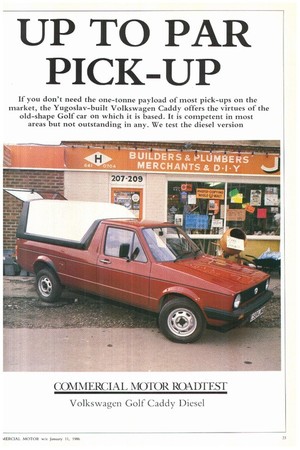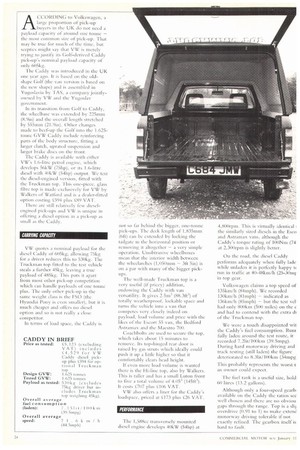UP TO PAR PICK UP
Page 23

Page 24

Page 25

If you've noticed an error in this article please click here to report it so we can fix it.
If you don't need the one-tonne payload of most pick-ups on the market, the Yugoslav-built Volkswagen Caddy offers the virtues of the old-shape Golf car on which it is based. It is competent in most areas but not outstanding in any. We test the diesel version
ACC:0121)1NC; to Volkswagen, a large proportion of pick-up buyers in the UK do not need a payload capacity of around one tonne — the most common size of pick-up. That may be true for much of the time, but sceptics might say that VW is merely trying to justify its Golf-derived Caddy pick-up's ii 011111 payload capacity of only 605kg.
"lhe Caddy was introduced in the UK one year ago. It is based on the oldshape Golf (the van version is based on the new shape) and is assembled in Yugoslavia by TAS, a company jointlyowned by VW and the Yugoslav government.
In its tralisition from Golf to Caddy, the wheelbase was extended by 225mm (8.9in) and the overall length stretched by 555mm (21.9M). Other changes made to beef-up the Golf into the 1.623tonne GVW Caddy include reinforcing parts of the body structure, fitting a larger clutch, uprated suspension and larger brake discs on the front.
The Caddy is available with either VW's 1.6-litre petrol engine, which develops 56kW (7511p), or its 1.6-litre diesel with 40kW (5411p) output. We test the diesel-engined version, fitted with the Truckman top. This one-piece, glass fibre top is made exclusively for VW by Walkers of Watford and is a dealer-fitted option costing 1:594 plus 189 VAT.
There are still relatively few dieselengine(' pick-ups and VW is unique in offering a diesel option in a pick-up as small as the Caddy.
CARRPC CAPACITY VW quotes a nominal payload for the diesel Caddy of 605kg; allowing 75kg for a driver reduces this to 530kg. The Truckinan top fitted to the test vehicle steals a further 45kg, leaving a true payload of 485kg. This puts it apart from most other pick-up competition which can handle payloads of one tonne plus. The only other pick-up in the same weight class is the FS() (the Hyundai Pony is even smaller), but it is much cheaper and offers no diesel Option and so is not really a close competitor.
In terms of load space, the Caddy is
CADDY IN BRIEF Price as tested: V5,123 (excluding VAT) includes (4,529 for VW Caddy diesel pickup plus 1:594 for optional Truckman top Design GVW: 1.625 tonnes Tested GVW: 1.625 tonnes Payload as tested: 530k g (excludes Mks; driver but includes Truck man top weighing 45kg).
Overall average fuel consumption
(laden): 7. 1 5 lit/ I 00krn
(39.intpg) Overall average speed: 7 1 . 6 k in h (44.5mph) not so far behind the bigger, one-tonne pick-ups. The deck length of 1,835mm (611) can be extended by locking the tailgate in the horizontal position or removing it altogether — a very simple Operation. Unobtrusive wheelboxes mean that the interior width between the wheelarches (1,050mm — 3ft 5in) is on a par with many of the bigger pickups.
The well-made 'Truckman top is a very useful (if pricey) addition, endowing the Caddy with van versatility. It gives 2.5m3 (88.3ft3) of totally weatherproof, lockable space and turns the vehicle into a van that competes very closely indeed on payload, load volume and price with the likes of the Escort 55 van, the Bedford Astramax and the Maestro 700.
Coachbolts are used to secure the top, which takes about 15 minutes to remove. Its top-hinged rear door is raised by gas struts which ideally could push it up a little higher so that it comfortably clears head height.
If even more load volume is wanted there is the Hi-line top, also by Walkers. This is taller and has a small Luton front to five a total volume of 4.053 (145ft3). It costs i707 plus 1:106 VAT.
VW also offers a liner for the Caddy's loadspacc, priced at 073 plus 426 VAT.
PERFORMANCE The I,588cc transversely mounted diesel engine develops 40kW (54hp) at
4,800rpm. This is virtually identical! the similarly sized diesels in the Esco and Astramax vans, although the Caddy's torque rating of 100Nm (74. at 2,300rpm is slightly better.
On the road, the diesel Caddy performs adequately when fully lade while unladen it is perfectly happy tt run in traffic at 40-48km/h (25-30m in top gear.
Volkswagen claims a top speed of 135km/h (84mph). We recorded 130km/h (81mph) — indicated as 136km/h (85mph) — but the test yd. had only 800km (5)10 miles) on the c and had to contend with the extra di of the 'Fruckman top.
We were a touch disappointed wit the Caddy's fuel consumption. Runt fully laden around the test route, it recorded 7.21it/100km (39.5mpg). During hard motorway driving and track testing (still laden) the figure deteriorated to 8.3Iit/ 100km (34mpg This probably represents the worst t an owner could expect.
The fuel tank is a useful size, hold 60 litres (13.2 gallons).
Although only a four-speed gearh. available on the Caddy the ratios see well chosen and there are no obviou gaps through the range. Top is a sliE overdrive (0.91 to 1) to make extend motorway driving tolerable if riot exactly refined. The gearbox itself is hard to fault.
OLINC
rolkswagen seems to have struck a {I ride/handling compromise with Caddy. Front suspension is coil ng straight from the Golf car (but uprated springs). At the back there rigid axle with leaf springs instead he torsion bar and coil sprung Ling, arm axle used in the Golf car retained for the Golf van.
,ven fully laden, the Caddy sits Ale] to the ground.
ERIOR Ligroin'
nude, the Caddy is standard early If. This is ergonomically sound, but A.' rather bland compared with the ised interior of the Golf van and the !st competition, Everything is black, eyed only by the white flecks in the Tic of the comfortable and supportive ts. The floor covering is a sensible iberised PVC.
/isibility is aided by sonic truck-sized -if-mounted mirrors but the neartical rear window of the Truckman quickly becomes almost opaque in weather and cries out For a rear )er.
'he fact that the Caddy is assembled iTugosiavia need nor give rise to fears Ait the quality control; VW is at pains mint out that there is German ervision. Our test vehicle was well shed and had a traditional VW trait he doors needed a good slant to OVerCOille the internal air pressure.
Engine noise is higher than average; there is a pronounced clackety-clack on tick-over alld a degree of wind noise that seems to he generated around the front pillars. I lowever, the pick-up benefits from the lack of body-panel drumming and so the total noise readings level out at average.
Under the bonnet, accessibility is first class. All the service items are to the fore and there is plenty of space around the transverse engine. The service schedule is based on 12-month intervals, supplemented for die diesel engine with an oil and oil rilter change every X,001i km (5,110) miles).
SUMMARY
Because of the lack of competing similarly-sized diesel pick-ups it is difficult to compare the Caddy. Accepting VW's assertion that its limited payload capacity is not a disadvantage to many pick-up buyers, the Caddy is capable if uninspiring. Rather like the Golf car it is not exciting in any one department but competent all round.
Unusually for a Volkswagen, its price is one of its strong points and it comfortably undercuts most of the one tonne pick-ups. The Golf car has earned itself a reputation for reliability, durability and high resale value; it is reasonable to expect the SAM(' of the Caddy. These qualities, combined with the competitive price, should endow the Caddy with a low cost of ownership.






















































